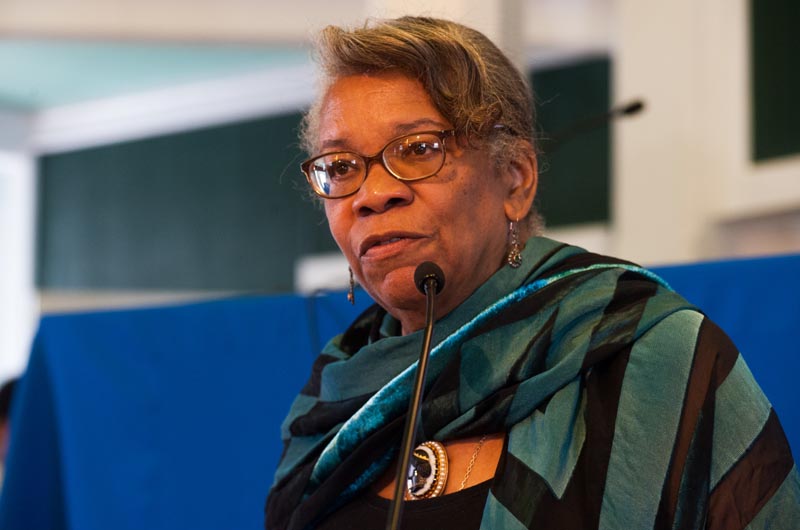Olive Tomlinson remembered the cottages and the shared car rides, the simplicity of summer life. With just a few phrases, Jessica Harris evoked memories of front porches and morning swims. Skip Finley recalled his first summer jobs, coin diving, then dessert making at the Ocean View. David Van Allen spoke of basketball tournaments and dances at Cottagers Corner, where 45s spun on turntables and gave way over time to DJ equipment.

“The same families would come back,” Mr. Van Allen said of his summers in Oak Bluffs. “And with your own children, it starts all over.” Mr. Van Allen is the fifth generation in his family to own Shearer Cottage, a bed and breakfast founded in 1912 by Charles Shearer, a former slave.
Mr. Van Allen was one of several residents who joined a panel discussion at Oak Bluffs: A Place of Pride and History, an event last Thursday devoted to discussing the role Oak Bluffs has played in the African American community. Nearly 200 people came to Union Chapel for the afternoon discussion and film screening, which was sponsored by Martha’s Vineyard Magazine in partnership with the Smithsonian Institution.
Oak Bluffs, Ms. Harris said, is a place of “repose and reconnection.”
Soon, Oak Bluffs and its deep sense of local community will be connected to the international community as well. It is one of 10 towns that will be featured in a permanent exhibition called The Power of Place, at the Smithsonian’s National Museum of African American History and Culture. The museum is scheduled to open in 2016.
Thursday’s event was a chance to learn about the development of the museum itself, in addition to how Oak Bluffs came to be featured at the museum.
“Oak Bluffs is indeed a powerful place in our African American community and in the United States,” said featured speaker Barbara Lee, who represents California’s 13th District in the House of Representatives and was a cosponsor of the 2003 bill that created the museum.
Ms. Lee is “no stranger to the power of place,” she said. Being in Oak Bluffs, she added, “really settles my spirit.”
“We all know that stories about region are important,” said exhibit curator Paul Gardullo. “But [we wanted] stories about places, places that people live and work in, places that people may leave behind but keep in their memories. We wanted to bring intimate stories.”
He and his colleagues made a list of potential places, and “of course Oak Bluffs was on that list from very early on,” Mr. Gardullo said. And it stayed on the list.
“In showcasing a variety of stories, I was interested in the idea of sites of leisure,” he said. But in researching more, he found that Oak Bluffs was more than that; it was a site of refuge. Mr. Gardullo said he drew on a Maya Angelou quote while focusing his efforts: “The ache for home lives in all of us, the safe place where we can go as we are and not be questioned.”
And that was exactly the sense in Oak Bluffs, said project historian Kevin Strait. Mr. Strait himself spent summers on the Vineyard for much of his life.

“Long before my work at the museum, I remember my grandmother telling me that Oak Bluffs was a place where families could purchase summer homes, have a vacation, just sort of be themselves,” he said.
In returning to the Vineyard to research the exhibit, Mr. Strait focused his work on Shearer Cottage and the family cottage of late Congressman Adam Clayton Powell — or, more specifically, their front porches. When he was growing up, the front porch in Oak Bluffs had an important role for Mr. Strait’s own family.
“I definitely took the importance of all that for granted,” he said. “I see now how those porches served as a hub. They’re rooted in history, but always changing, ever changing.”
Dr. Lonnie Bunch, director of the museum, explained the goals he and his staff kept in mind while embarking on the journey to create the museum. It has to be a place to honor the rich history and culture of the African American experience, while also taking care to remember “all those people who had been left out,” he said. It will be a place to wrestle with culpability, Dr. Bunch said, but also a place to tap into joy.
And, he said, “it also has to be a place about celebrating communities.”








Comments (1)
Comments
Comment policy »